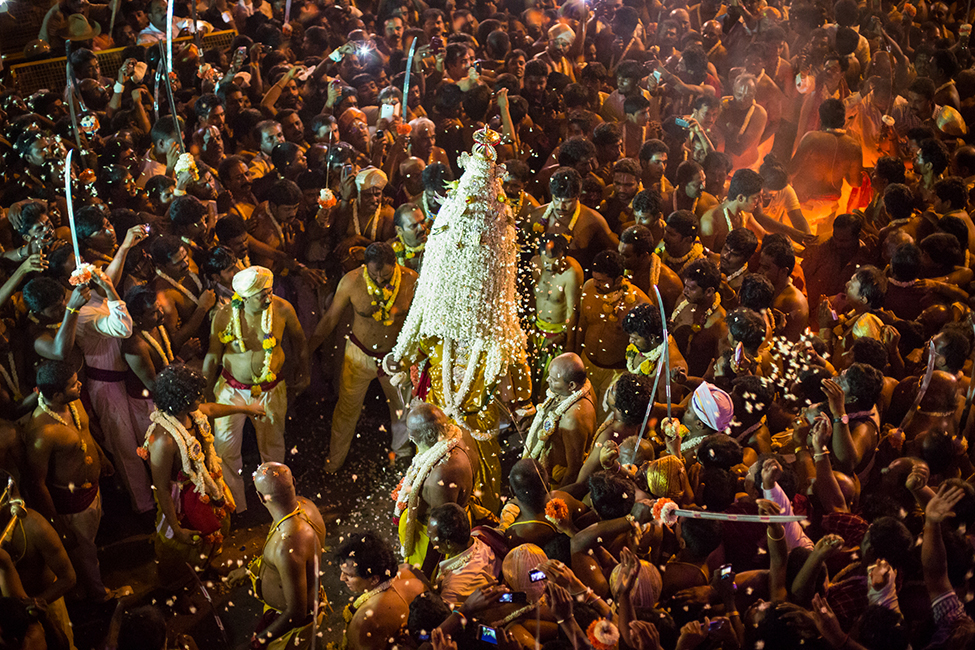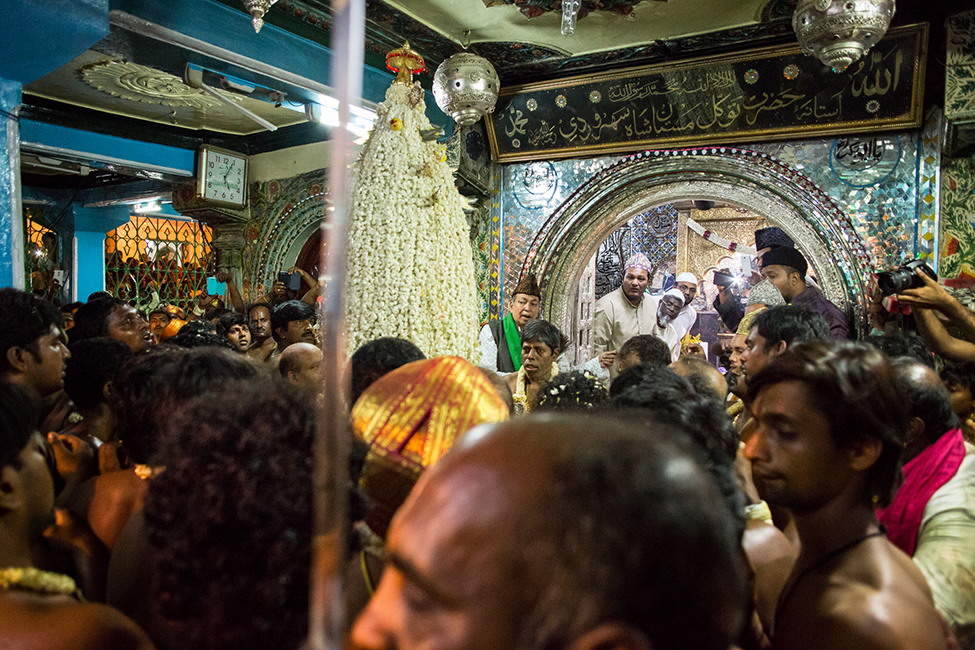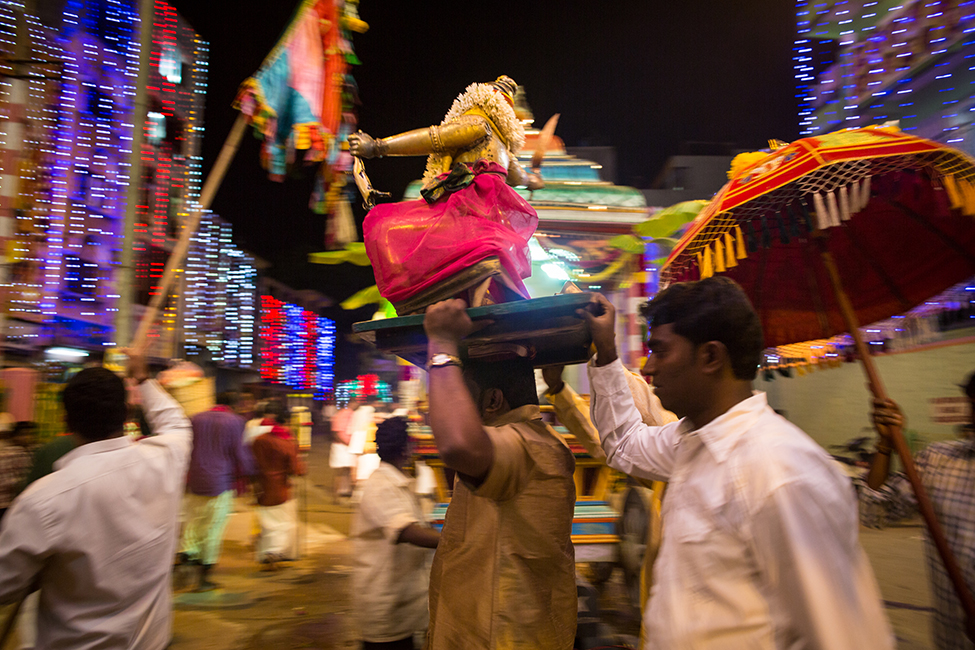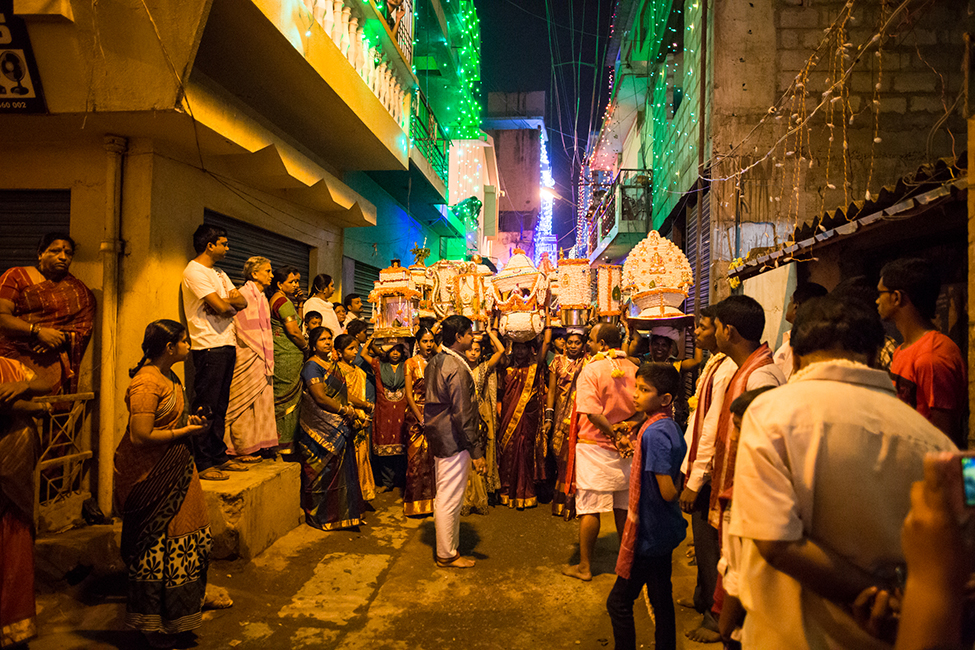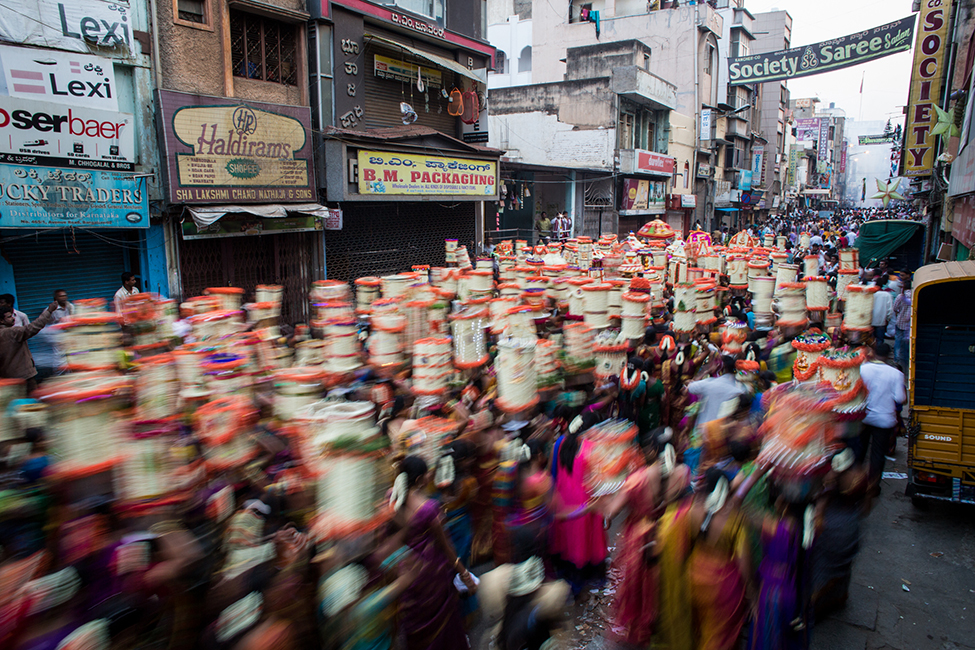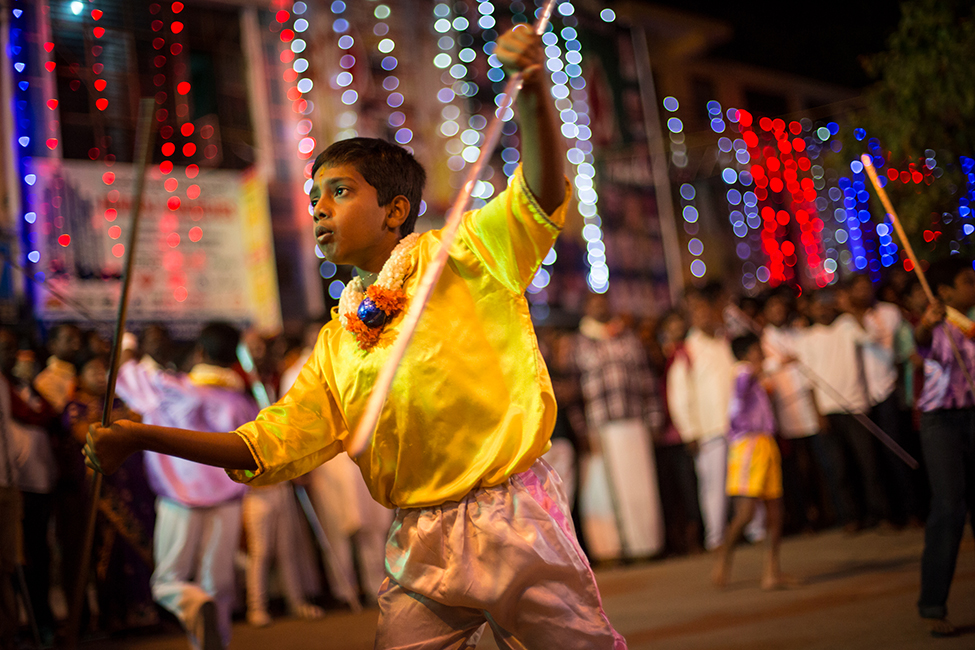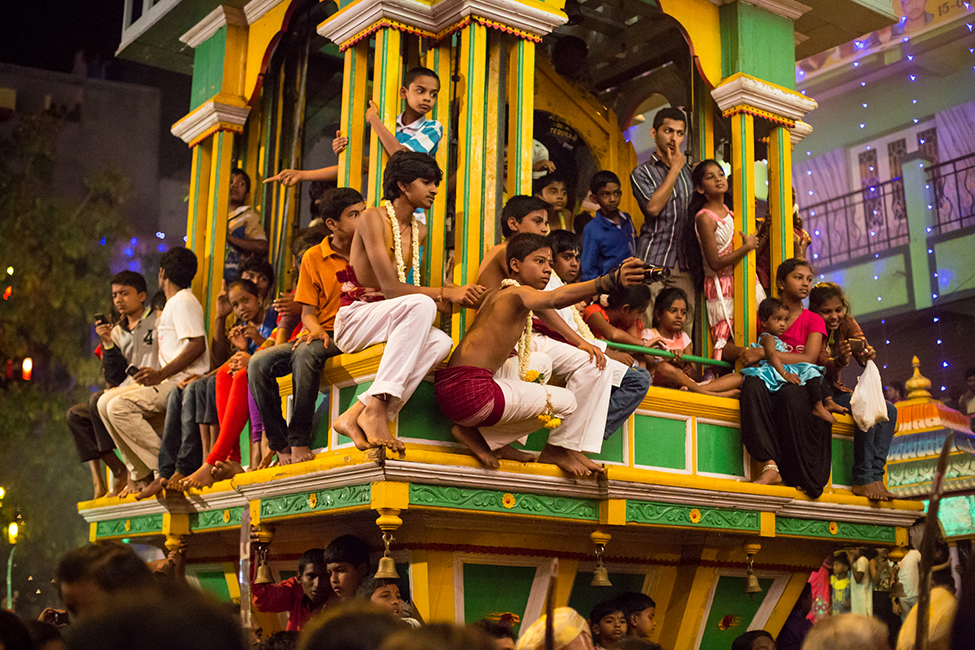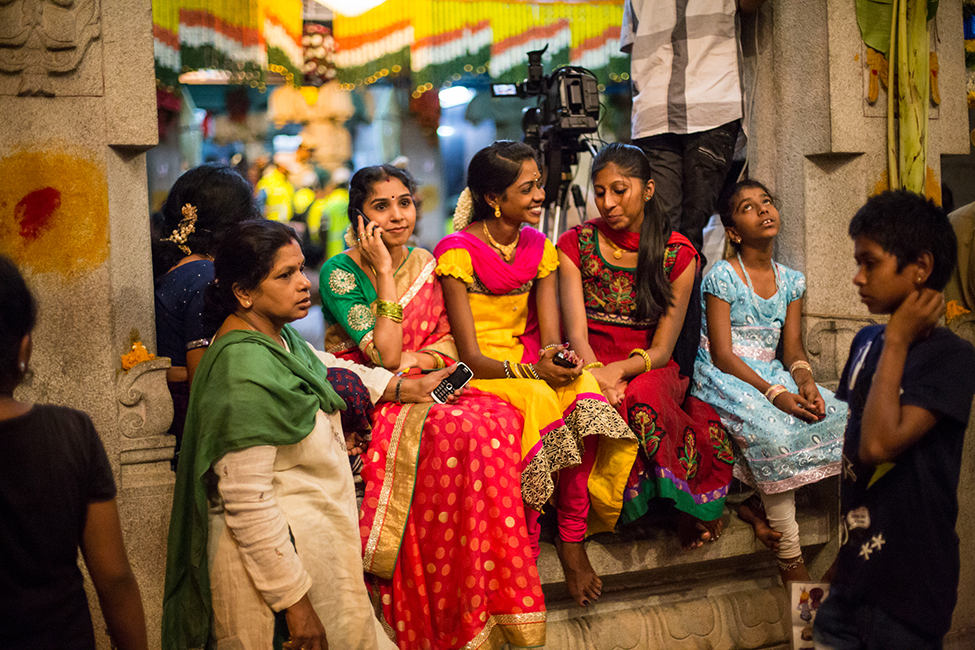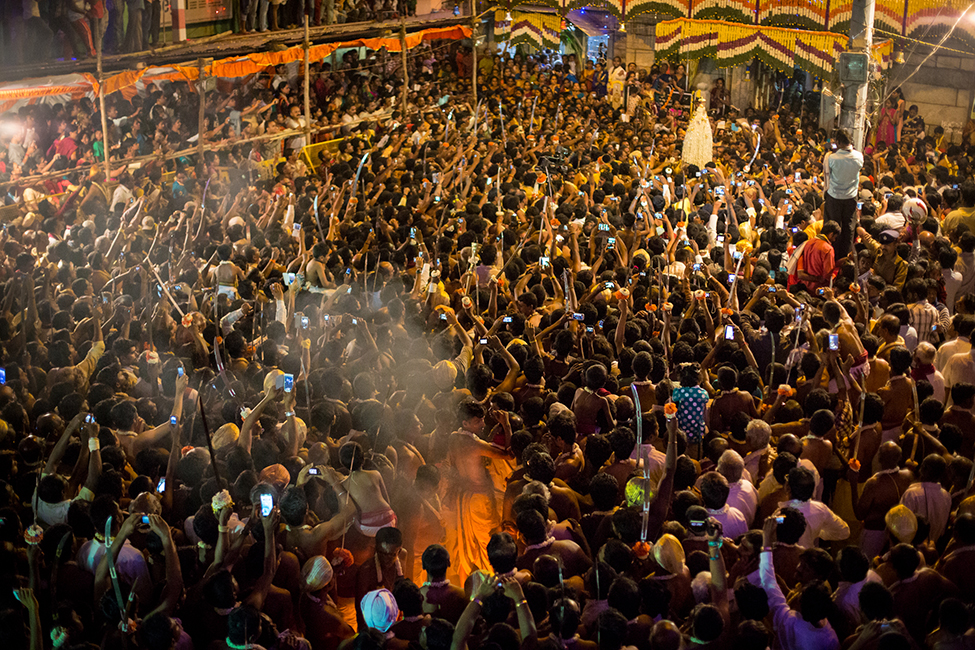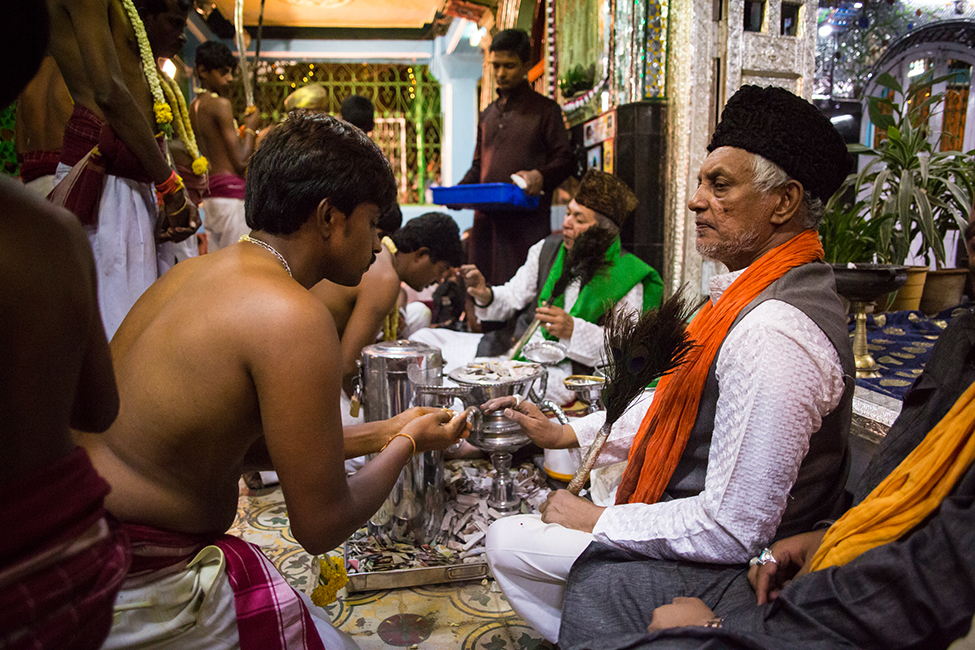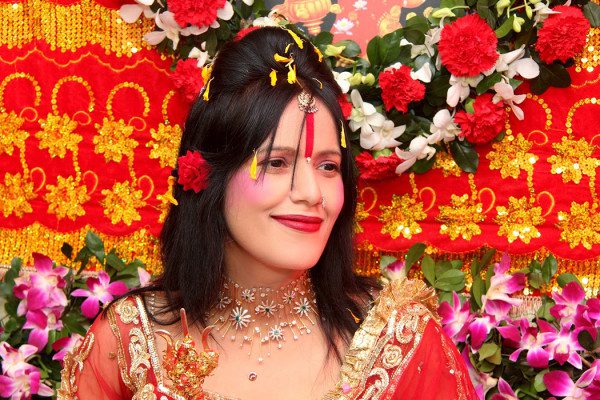A photowalk through Pete chronicling the Karaga festival …by Vivek Muthuramalingam….
The lasting impression that lingers in my mind after having witnessed one of Bangalore’s oldest and biggest festivals is strangely not that of visual nature. It is of a sustained sound that left a particular hand bell, among the many that heralded the arrival of the Karaga, as it passed through the claustrophobic lanes of the Pete. It was neither particularly loud, nor tore through the cacophony that enveloped the procession, but to the discerning ear it was certainly distinguishable. ‘Tinn-tak, tinn-tak, tinn-tak’ it resounded in the air, with every alternative ring being deliberately dampened to create a distinct rhythm that was persistent and patient. It was a sound that stayed closest to the Karaga, trailing wherever it went, and in a strange way the memory of it brings back an emotion of both excitement and fear. It was for me, the background score of the festival.
The Karaga enters the Dargah of Hazrat Tawakkal Mastan Shah, an 18th-century Sufi saint who, according to one legend, is said to have blessed a harried Karaga bearer with enough strength to complete the daunting task. Since then, a stop here has become an inevitable part of the Karaga’s itinerary, as a gesture of obeisance to the saint.
The first day of the Karaga begins with the hoisting of the flag and a procession of the temple idols. Seen here is the idol of a minor deity Potharaj, the brother-in-law of the Pandavas, being brought out. He wields a sword on his right hand and a goat in his left.
The sixth day of the festival is devoted to the women of the community who come together for aarathi utsava, a ritual that involves lighting the divine lamp, the ‘aarathi’, enclosed within a vessel decorated with jasmine and red Kanakambara flowers, called Yelkunga. They start out late at night from the temple initially in small groups, and are gradually joined by other women carrying Yelkunga as they parade in the Pete area.
Ever since I was aware of its existence my reaction was one of sensible evasion. “It will be crowded beyond belief.” “It is impossible to coax out a unique perspective.” “Chances are, you will be mugged.” Yet, well aware that it has been fairly documented and photographed repeatedly every year, I heaved myself towards the Karaga festival eager to make my own inferences. Fellow photographers, some of whom had proudly covered many editions of it in the past, were generous with their unsolicited advice. One however proved particularly valuable that I later unfailingly followed – go early to stake claim to a spot to photograph from and, stay put. They were of course referring to the pandemonium that unfolds on the pinnacle of the 11-day long festival when swarms of devotees, spectators and photographers like me jostle with each other, often violently, to catch a glimpse of the ‘Karaga’ – a term that is referred to a male priest in a woman’s attire, balancing a lavish pyramid of jasmine on his head.
As the aarathi utsava comes to a culmination in the wee hours, the arterial street of Avenue Road is seen bustling with women carrying the Yelkunga, before they head back to the temple for a final pooja (prayer).
The role of garadi mane, the traditional gymnasiums, is significant to the Karaga festival. Since carrying the Karaga is also a physically demanding task, the ordained bearer also spends time at the gymnasium in preparation of the event. Some of the students from these gymnasiums display their skills on the day of aarathi utsava.
The jasmine Karaga that takes place on the 9th day of the festival is preceded by many fascinating ceremonies, one of which is the Hasi Karaga. Sediment from the Sampangi Tank, considered by Tigalas as one of the places of spiritual significance, is wrapped in a bright red cloth and adorned with jasmine strings and jewellery. The Karaga bearer then gingerly balances it on his hip and walks back to the Dharmarayaswamy Temple in a ceremony that happens late at night.
The Karaga is the most important festival of the Tigalas. It usually falls in the summer months of March and April but thankfully, most ceremonies that draw the crowds are held during the cool respite of late night. The Tigalas are traditionally considered expert gardeners and are widely acknowledged to have played a significant role in the upkeep of the city’s green cover. Lalbagh is a great example of this, having been commissioned by Hyder Ali himself to develop and maintain the gardens, over two centuries ago.
The Karaga creates a vibrant memory in an entirely new generation of spectators, eager to watch the Hasi Karaga. With a documented history of more than 400 years, the festival has an unbroken legacy of having been celebrated every single year and has enjoyed immense royal patronage throughout.
It’s a great occasion for the entire Tigala community to come together and catch up on everything that has passed them by. A section of the Pete (old Bangalore) area is called Tigala rapete, referring to the predominance of the community in the region.
The festival is hosted at one of the oldest temples of the Tigalas – the Dharmarayaswamy Temple – situated in the perpetually congested Pete area of central Bangalore. The temple is a rarity since it is one of the few devoted to the Pandavas, the mythological heroes of the epic Mahabharata who aren’t usually seen designated as deities. The core of the festival however revolves around their princess Draupadi, who is believed to have put together an army of warriors called Veerakumaras to help slay a demon, Tripurasura. The Tigalas believe that they are the progeny of this warrior clan and as a sign of gratitude for their succour the celestial Draupadi spends three days with them every year. The festival is thus a celebration of her stint with them and in essence signifies the Tigalas’ invoking of Draupadi’s immense power of femininity.
Gyanendra A, the head priest at the Dharmarayaswamy Temple and also the ordained bearer of the Karaga this year is seen performing a series of rituals at the temple, hours before he lifted the Karaga.
The very first sight of the Karaga as it exits the temple at 1.50 in the morning. The crowd parts in waves in its wake, as a sense of feverish excitement sets in.
On the ninth day of the festival, just before the temple square was packed to the gills, I had managed to make my way up a large window on the first floor of a building close-by that gave me unhindered views of the scene below. Bappi from Odisha who works at a gold refining trade housed in the same building, was kind enough to let me in. My prized vantage point was shared with Panneerselvam, who revealed that he is a Catholic and works with the Indian Institute of Astrophysics. He had never missed the festival in the last 25 years as if this was some kind of an annual sporting event. “There is certainly some shakti in the Karaga,” he confessed simply, without elucidating further.
Considered extremely auspicious to receive a lemon from the hands of the Karaga bearer, there is always a mad scramble whenever the Karaga pauses momentarily to hand them out.
The uniqueness of the Bangalore Karaga is most certainly its secular spin. The Veerakumaras awaiting the arrival of the Karaga at the Dargah of Hazrat Tawakkal Mastan Shah receive blessings from Muslim clergy.













